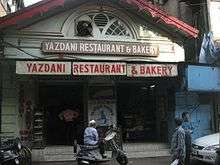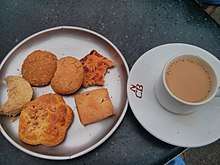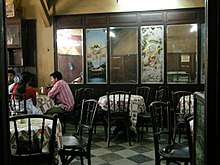Irani café


Irani cafes are Iranian-style cafes in South Asia.[1] They were originally opened by Zoroastrian Irani immigrants to modern India and Pakistan in the 19th century.[2] Today, Hyderabad boasts the largest number of Irani cafés, which are very popular for Irani chai (tea).[3][4]In the 1950s, there were 350 Irani cafés; today, only 25 remain.[1] One of the most popular eating places is the 102-year-old Kyani Café, a heritage landmark in south Mumbai.

Fare
Mumbai cafés may serve bun maska (bread and butter)[5] and paani kam chai (a strong Iranian tea), or khari chai (very strong tea), mutton samosas, and Kheema Pavs, akuri, berry pulao, vegetable puff, vegetarian/chicken Dhansak (a spicy broth with lentils, pulses) and Biryani, cherry cream custard, cheese khari biscuits, plain khari biscuits, coconut jam and milk biscuits and Dukes Raspberry drink. The Parsi Bhonu (meal) is available at most Irani restaurants.
Many Irani cafes offer sweet and salted biscuits[6] like Rawa (semolina), Til Rawa Coconut, nan-khatai (sweet, crisp flaky Irani biscuits), Madeira-Cake (tutti-frutti biscuits).
Writing for the Hindu Business Line, on "Mumbai's Irani hotspots", Sarika Mehta stated, "The classic format of these cafes is basic with a subtle colonial touch; high ceilings with black, bent wooden chairs (now cane in some cafes), wooden tables with marble tops and glass jars that allow a peek into the goodies they hold. With huge glass mirrors on the walls to create a feeling of space, visitors are greeted with eagerness and a whiff of baking. The speed of operations is impressive and service quite hassle-free."[7]
Cultural references

Nissim Ezekiel wrote a poem based on instruction boards found in his favourite Irani café; the now defunct Bastani and Company, in Dhobi Talao, Mumbai.[8]
Footnotes
- 1 2 Jayshree Bajoria (27 April 2005). "India's Iranian cafes fading out". BBC News. Archived from the original on 8 October 2007. Retrieved 25 December 2007.
- ↑ Noorani, Asif (10 September 2016). "Looking back at Karachi's Irani cafe culture". Dawn. Retrieved 10 September 2016.
- ↑ "Quintessentially Hyderabadi—Irani Tea". New Indian Express. 6 March 2015. Retrieved 20 November 2017.
- ↑ Naomi Lobo (May 20, 2007). "Irani cafés: Inheritance of loss". India Express. Archived from the original on February 6, 2012. Retrieved December 25, 2007.
- ↑ Miguel, H.S. (2012). Mumbai. Intellect Books - World Film Locations Series (in Indonesian). Intellect Books. p. 58. ISBN 978-1-84150-632-6. Retrieved 21 February 2018.
- ↑ Damle, J.Y. (2011). Pune: Tradition to Market: a Study of Changing Trends in Consumption with Special Reference to Service Sector in Hotel Industry. Kalpaz Publications. p. 117. ISBN 978-81-7835-895-6. Retrieved 21 February 2018.
- ↑ "Archived copy". Archived from the original on 2007-10-02. Retrieved 2007-12-24.
- ↑ "Sunanda Sudhir". newsblog.aol. Retrieved 2007-12-25.
Further reading
External links
| Wikimedia Commons has media related to Irani cafe. |